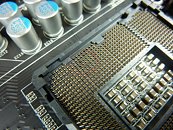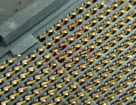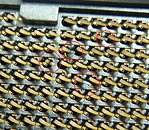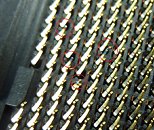Monday, January 17th 2011

Socket Pin Burnout Returns to Haunt LGA1155?
Last year, credible reports of a design defect with LGA1156 sockets made by a certain component manufacturer in particular, made headlines. Reviewers found that extreme overclocking using increase voltages, in test cases, caused certain pins of the socket to burn out, damaging both the board and processor. The defect was found to be caused by shorting between the pins and the socket causing tiny electrical arcs. Motherboard reviewer from TechReaction.net discovered that his Gigabyte GA-P67A-UD4 and GA-P67A-UD7 samples showed signs of socket burn. The publication is yet to receive a reply from the board manufacturer.
LGA1155 and LGA1156 are very similar in physical pin layout, chip package, and retention clips, although the pin-maps are significantly different. TechReaction comments that while only "extreme conditions" cause such pin burnouts, 24/7-stable overclocked settings could, over a period of time, create similar conditions. Only time, and extensive testing will reveal if burnouts are a cause for concern to enthusiasts.
Source:
TechReaction
LGA1155 and LGA1156 are very similar in physical pin layout, chip package, and retention clips, although the pin-maps are significantly different. TechReaction comments that while only "extreme conditions" cause such pin burnouts, 24/7-stable overclocked settings could, over a period of time, create similar conditions. Only time, and extensive testing will reveal if burnouts are a cause for concern to enthusiasts.




65 Comments on Socket Pin Burnout Returns to Haunt LGA1155?
And, IIRC, the issue with 1156 was that Intel changed the design specs closely before launch because they realized the issue, and Foxconn shipped some parts that followed the old spec sheet. I doubt that happened with 1155 since the hold down spec sheat was the same as 1156.Ok, post some screenshots of your own rig doing some benchmarks at your 24/7 clocks, and I'll post mine with the same benchmarks, we'll see who gets the higher scores. Then we can compare prices and see who paid less.:toast:So you think one suicide run, that wasn't even stable beyond getting a GPUz screenshot, is a valid come back to fact that a lot of SandyBridge chips can run 5.0GHz 24/7 totally stable on air?Since LGA2011 is going to use the same hold downs as 1155/1156, the chances of having the same problem, by your logic, will be the same. Of course, as we already went over this, the board was used and came to the reviewer like that, so we have no idea how much voltage was pushed through the stocket or even if the stocket was damaged prior to the pins being burnt.
Also, the problem with 1156 was fixed before it was even released, it was crappy Foxconn hold downs that caused the issue, not the socket or hold downs design themselves.While that is a good example, the LGA1366 socket only really has about 25 more power contacts compare to LGA1156/1155. And those pins are needed because 1366 processors consume more power. So while 2 pipes will easily fead the water needs of a 2 bathroom house, 3 are needed to feed a 3 bathroom house, because the 3 bathroom house uses more water.You are correct, but press is nothing more than word, it doesn't matter in the real world use. You can say OMG Toyota sucks all over the press, that doesn't mean they are actually bad, and it definitely doesn't mean I'm running to trade in my Camery with 200,000 miles on it that is still running perfectly(while my Chevy with 70,000 has done nothing but break down).I don't see many people whining about it crapping out. The only people that whined were the extreme overclockers that were effected by the arcing problem, it didn't happen in normal enthusiast usage, and those people likely got the hardware for free. So it is pretty hard to cheap out when you are getting the stuff for free. And of course quality isn't what you are paying more for on 1366, there are some pretty shitty 1366 boards out there that are far below the quality of some 1156 boards, you are paying for the artifical sense of extra performance that x16/x16 and Tri-Channel RAM gives you.
If these were samples this is people making a mountain out of mole hill, if these were legit consumer boards, then GB may be at fault. But 2 boards for 1 person a well known fatal flaw does not make.
:toast:
www.anandtech.com/bench/Product/142?vs=287
For the record, I'm moving to 1155. It overclocks better and performs better clock for clock with nicer features and lower power consumption. Your whole mainstream el-cheapo shtick is a looney lie you tell yourself just so you don't have to feel inadequate about your rig for another year. As of right now there is no more mainstream vs highend sockets for intel. Just old and new and the less old but more unwanted (1156).
And here's your preferred comparison. Not that you want to see it in this case. www.anandtech.com/bench/Product/287?vs=142
Wins 67% of the time, and hits 5 GHz without spoiling like old milk. Going "mainstream" isn't "cheap", it's what you do if money doesn't grow on trees. Not that 1155 is really any cheaper than your normal 1366 rig to begin with so that entire aspect of your rage fit didn't make sense to begin with. Same with the durability crap, if anything SB can take more voltage than it's 1366 32nm counterparts.
I do agree this is mountain out of molehill material.
I am sure the fortunate few whom do receive an "engineering sample" have developed the skills necessary to create the identifiers to problems that should be addressed to revisions necessary prior to production.
Going from 1366 pin to 1156...well and trying to get more energy saving features and trying to interface video with higher performance than 1366 is a challenge.
Last time I checked, pin count always risen in count with new architecture not the other way around, looks like another Intel dead end product line.
Little extreme, don't you think?
It's just absurd for anyone to assume this has any bearing on P67 durability.
How many years did socket seven and 775 last? 1366 didn't come out to long ago, now 1155/1156, soon to introduced 20xx pin?
Intel Dead End products lines based on more than a single board architecture, so disposable money minded end-users can upgrade continuously in the wash cycle.I'll try to stay on topic and go to the source, the lucky few whom have the skills to identify problems that need to be addressed prior to mainstream production. As it may appear that the Foxconn supplier may have had a new socket product interface error than may needed to looked into and revised for what ever reasoning dreamed necessary.
I do not see a fewer than 1155/1156 pin count in the next pin cycle and I also dought the majority of big business that still using reliable proven 775 hardware migrating to 1366 last year to 1156 this month only to repurchase next month to 1155 to anticipate for-site upon revamping to 20xx next year realizing the dead end architecture so to be abandoned?
PS: I'm fine with buying both a new board and cpu if it provides the advances I'm looking for. If I have the money for LGA2011, and it does what I want, I'll buy it. I'll not limit myself over some false sense of wrong doing on Intel's part. Nobody FORCES you to upgrade at all. I simply buy the best performing product for the money I am willing to spend.